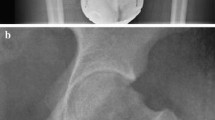Abstract
Purpose
Radiological evaluation of femoroacetabular impingement is based on single-plane parameters such as the alpha angle or the center edge angle, or complex software reconstruction. A new simple classification for cam and pincer morphologies, based on a two-plane radiological evaluation, is presented in this study. The determination of the intraobserver and interobserver reliability of this new classification is the purpose of this study.
Methods
We retrospectively reviewed the three-view hip study in patient undergoing hip arthroscopy for FAI syndrome between October 2015 and April 2016. Any case having protrusio acetabuli, coxa profunda or which has undergone previous osteotomic surgery was excluded. Five observers used our proposed classification to identify three different stages for the cam and pincer morphologies. Inter- and intraobserver agreement of classification was determined using average pairwise Cohen’s kappa coefficient.
Results
The interobserver agreement for the pincer and cam morphologies was excellent. For the pincer morphology classification, the average Kappa agreement was 0.838 (range 0.764–0.944). For the cam morphology, the average pairwise Cohen’s kappa coefficient was 0.846 (range 0.734–0.929). The intraobserver agreement was excellent as well. The average percent pairwise agreement was 0.870 and 0.845 for pincer and cam type, respectively.
Conclusions
The new classification system shows excellent levels of inter- and intraobserver agreement for both deformities. This classification is demonstrated to be a useful tool in planning hip arthroscopy. Further studies are needed to correlate the classification itself with specific intraoperative findings.







Similar content being viewed by others
References
Ganz R, Parvizi J, Beck M et al (2003) Femoroacetabular impingement: a cause for osteoarthritis of the hip. Clin Orthop Relat Res. https://doi.org/10.1097/01.blo.0000096804.78689.c2
Leunig M, Ganz R (2005) Femoroacetabular impingement. A common cause of hip complaints leading to arthrosis. Unfallchirurg 108:9–10, 12–17. https://doi.org/10.1007/s00113-004-0902-z
Rühmann O (2008) Arthroscopy of the hip joint: indication, technique, results. Dtsch Ärzteblatt Int 105:559–566. https://doi.org/10.3238/arztebl.2008.0559
Pollard TCB, Villar RN, Norton MR et al (2010) Femoroacetabular impingement and classification of the cam deformity: the reference interval in normal hips. Acta Orthop 81:134–141. https://doi.org/10.3109/17453671003619011
Bouma HW, Hogervorst T, Audenaert E et al (2015) Can combining femoral and acetabular morphology parameters improve the characterization of femoroacetabular impingement? Clin Orthop Relat Res 473:1396–1403. https://doi.org/10.1007/s11999-014-4037-4
Ipach I, Mittag F, Sachsenmaier S et al (2011) A new classification for “pistol grip deformity”—correlation between the severity of the deformity and the grade of osteoarthritis of the hip. RöFo Fortschritte auf dem Gebiete der Röntgenstrahlen und der Nukl 183:365–371. https://doi.org/10.1055/s-0029-1245817
Ipach I, Arlt E-M, Mittag F et al (2011) A classification-system improves the intra- and interobserver reliability of radiographic diagnosis of “pistol-grip-deformity”. Hip Int 21:732–739. https://doi.org/10.5301/HIP.2011.8821
Siebenrock KA, Kalbermatten DF, Ganz R (2003) Effect of pelvic tilt on acetabular retroversion: a study of pelves from cadavers. Clin Orthop Relat Res 407:241–248
Dunn DM (1952) Anteversion of the neck of the femur; a method of measurement. J Bone Jt Surg Br 34-B:181–186
Lequesne M, de Seze (1961) False profile of the pelvis. A new radiographic incidence for the study of the hip. Its use in dysplasias and different coxopathies. Rev du Rhum des Mal ostéo-articulaires 28:643–652
Rippstein J (1955) Determination of the antetorsion of the femur neck by means of two X-ray pictures. Z Orthop Ihre Grenzgeb 86:345–360
Ogata S, Moriya H, Tsuchiya K et al (1990) Acetabular cover in congenital dislocation of the hip. J Bone Jt Surg Br 72:190–196
Goodman DA, Feighan JE, Smith AD et al (1997) Subclinical slipped capital femoral epiphysis. Relationship to osteoarthrosis of the hip. J Bone Jt Surg Am 79:1489–1497
Landis JR, Koch GG (1977) The measurement of observer agreement for categorical data. Biometrics 33:159–174
Meyer DC, Beck M, Ellis T et al (2006) Comparison of six radiographic projections to assess femoral head/neck asphericity. Clin Orthop Relat Res 445:181–185. https://doi.org/10.1097/01.blo.0000201168.72388.24
Arbabi E, Chegini S, Boulic R et al (2010) Penetration depth method—novel real-time strategy for evaluating femoroacetabular impingement. J Orthop Res 28:880–886. https://doi.org/10.1002/jor.21076
Chadayammuri V, Garabekyan T, Jesse M-K et al (2015) Measurement of lateral acetabular coverage: a comparison between CT and plain radiography. J Hip Preserv Surg 2:392–400. https://doi.org/10.1093/jhps/hnv063
Schottel PC, Park C, Chang A et al (2014) The role of experience level in radiographic evaluation of femoroacetabular impingement and acetabular dysplasia. J Hip Preserv Surg 1:21–26. https://doi.org/10.1093/jhps/hnu005
Nepple JJ, Martell JM, Kim Y-J et al (2014) Interobserver and intraobserver reliability of the radiographic analysis of femoroacetabular impingement and dysplasia using computer-assisted measurements. Am J Sports Med 42:2393–2401. https://doi.org/10.1177/0363546514542797
Funding
There is no funding source.
Author information
Authors and Affiliations
Corresponding author
Ethics declarations
Conflict of interest
All the authors declare that they have no conflict of interest.
Ethical approval
For this type of study, formal consent is not required.
Additional information
Publisher's Note
Springer Nature remains neutral with regard to jurisdictional claims in published maps and institutional affiliations.
Rights and permissions
About this article
Cite this article
Fioruzzi, A., Acerbi, A., Jannelli, E. et al. Interobserver and intraobserver reliability of a new radiological classification for femoroacetabular impingement syndrome. Musculoskelet Surg 104, 279–284 (2020). https://doi.org/10.1007/s12306-019-00618-x
Received:
Accepted:
Published:
Issue Date:
DOI: https://doi.org/10.1007/s12306-019-00618-x




